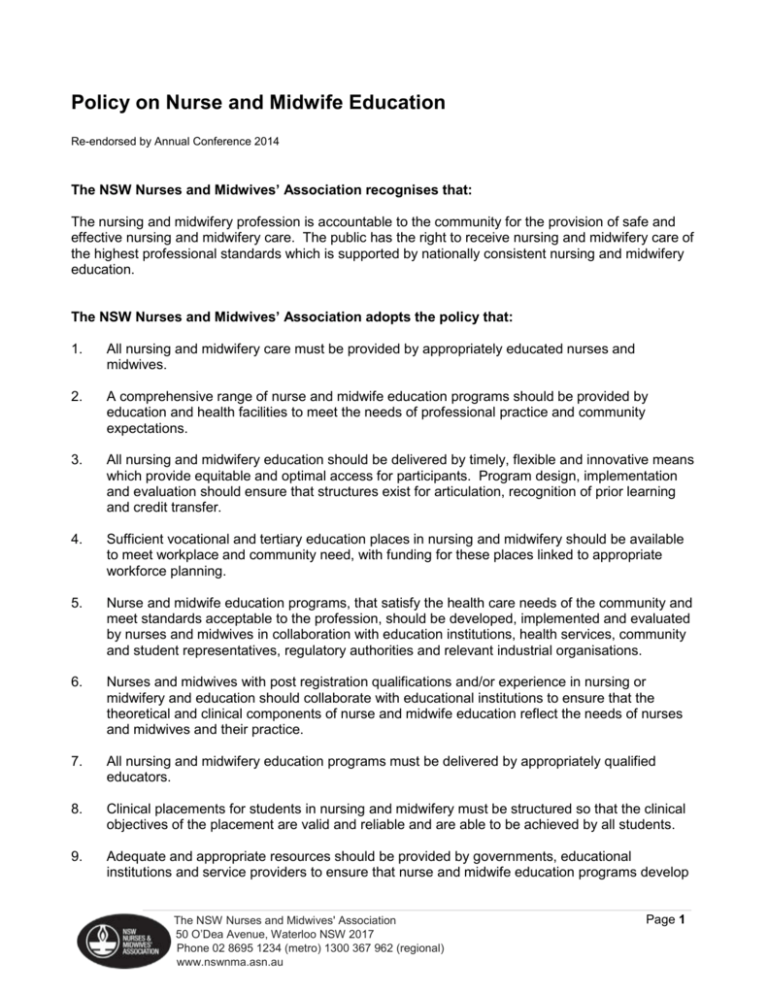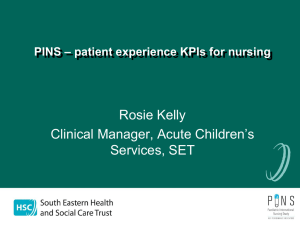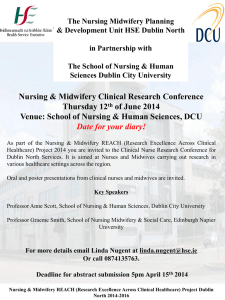Policy on Nurse and Midwife Education
advertisement

Policy on Nurse and Midwife Education Re-endorsed by Annual Conference 2014 The NSW Nurses and Midwives’ Association recognises that: The nursing and midwifery profession is accountable to the community for the provision of safe and effective nursing and midwifery care. The public has the right to receive nursing and midwifery care of the highest professional standards which is supported by nationally consistent nursing and midwifery education. The NSW Nurses and Midwives’ Association adopts the policy that: 1. All nursing and midwifery care must be provided by appropriately educated nurses and midwives. 2. A comprehensive range of nurse and midwife education programs should be provided by education and health facilities to meet the needs of professional practice and community expectations. 3. All nursing and midwifery education should be delivered by timely, flexible and innovative means which provide equitable and optimal access for participants. Program design, implementation and evaluation should ensure that structures exist for articulation, recognition of prior learning and credit transfer. 4. Sufficient vocational and tertiary education places in nursing and midwifery should be available to meet workplace and community need, with funding for these places linked to appropriate workforce planning. 5. Nurse and midwife education programs, that satisfy the health care needs of the community and meet standards acceptable to the profession, should be developed, implemented and evaluated by nurses and midwives in collaboration with education institutions, health services, community and student representatives, regulatory authorities and relevant industrial organisations. 6. Nurses and midwives with post registration qualifications and/or experience in nursing or midwifery and education should collaborate with educational institutions to ensure that the theoretical and clinical components of nurse and midwife education reflect the needs of nurses and midwives and their practice. 7. All nursing and midwifery education programs must be delivered by appropriately qualified educators. 8. Clinical placements for students in nursing and midwifery must be structured so that the clinical objectives of the placement are valid and reliable and are able to be achieved by all students. 9. Adequate and appropriate resources should be provided by governments, educational institutions and service providers to ensure that nurse and midwife education programs develop The NSW Nurses and Midwives' Association 50 O’Dea Avenue, Waterloo NSW 2017 Phone 02 8695 1234 (metro) 1300 367 962 (regional) www.nswnma.asn.au Page 1 the nursing and midwifery knowledge and skill required for providing quality care, and meet workforce and career path requirements. 10. The allocation and use of resources for nurse and midwife education should be based on advice from nurses and midwives. 11. Nurses and midwives beginning practice or commencing practice in a new area should have ready access to a nurse or midwife with relevant clinical experience and/or qualifications for support. 12. Assistants in Nursing 12.1 12.2 13. 14. Training and education must be provided at a Certificate III level by registered training organisations, which utilise appropriate systems for recognition of prior learning. The competency standards and education of assistants in nursing should relate to enrolled nurse competencies and education in such a way as to assist articulation and credit transfer between the two. Enrolled Nurses 13.1 The primary aim of pre-enrolment courses is to prepare a nurse to be able to demonstrate the Australian Nursing and Midwifery Council Nursing and Midwifery Board of Australia1 (2002) enrolled nurse competencies and to function as a safe and competent beginning clinical nurse under registered nurse supervision in a variety of settings. 13.2 The educational preparation of enrolled nurses should be conducted in the vocational education sector at the level required by regulatory authorities which facilitates articulation and credit transfer to registered nurse programs. 13.3 The central focus of pre-enrolment programs is enrolled nurse practice, understood as the provision of patient-centred nursing care, including the recognition of normal and abnormal in assessment, intervention and evaluation of individual health and functional status. Programs must address Aboriginal and Torres Strait Islander history health and safety, mental health and chronic disease management. 13.4 Principles and processes for pre-enrolment clinical placements, which will ensure the quality of such placements as learning experiences, must be developed. 13.5 Competent beginning enrolled nurses will have access to appropriate enrolled and registered nurses for support with transition to the workplace. Registered Nurses 14.1 The primary aim of pre-registration courses is to prepare a nurse to be able to demonstrate the Nursing and Midwifery Board of Australia (2005) registered nurse competencies for beginning practice and to function as a safe and competent beginning clinical nurse in a variety of health care settings. The NSW Nurses and Midwives' Association 50 O’Dea Avenue, Waterloo NSW 2017 Phone 02 8695 1234 (metro) 1300 367 962 (regional) www.nswnma.asn.au Page 2 15. 16. 14.2 Pre-registration programs will be conducted by faculties/schools/ departments of nursing located in universities with the minimum award leading to registration as a nurse being at bachelor level. 14.3 Principles and processes for undergraduate clinical placements, which will ensure the quality of such placements as learning experiences, must be developed. 14.4 The primary focus of pre-registration nursing programs is nursing practice understood in terms of nursing models and traditions of healthcare which emphasises health promotion, illness prevention and care of individuals across the lifespan, sick or well. Programs must be responsive to and reflect healthcare matters that have national and international significance, including but not limited to the national health priorities; remote and rural health, mental health and chronic disease self-management; aged care and primary health care. 14.5 Competent beginning clinical nurses will have access to a registered nurse with relevant clinical experience and/or qualifications for support and will not be placed in charge, or expected to function alone. Registered Midwives 15.1 The primary aim of courses leading to registration as a midwife is to prepare a midwife able to demonstrate the Nursing and Midwifery Board of Australia (2006) registered midwife competencies for beginning practice and to function as a safe and competent beginning clinical midwife in a variety of health care settings. 15.2 Midwifery programs will be conducted by faculties/schools/departments of nursing and midwifery located in universities with the minimum award leading to registration as a midwife being at bachelor level. 15.3 Principles and processes for clinical placements for midwifery students, which will ensure the quality of such placements as learning experiences, must be developed. 15.4 Comprehensive midwifery programs leading to registration as a midwife should be evidence-based and should include health assessment, care and management of the woman and her baby in both normal and complex situations including pathophysiology, pharmacology, medication administration, pain management, family planning, perioperative care wound management, haemodynamic management, infection control, care during medical and surgical emergencies and communication and mental health counselling skills. 15.5 Competent beginning clinical midwives should have access to a registered midwife with relevant clinical experience and/or qualifications for support and should not be placed in charge, or expected to function alone. Continuing Nurse and Midwife Education 16.1 The concept of continuing nurse and midwife education includes: professional development, post-enrolment courses, post-registration courses, postgraduate courses, re-training or skills transfer courses, and refresher training on re-entry to the workforce. The NSW Nurses and Midwives' Association 50 O’Dea Avenue, Waterloo NSW 2017 Phone 02 8695 1234 (metro) 1300 367 962 (regional) www.nswnma.asn.au Page 3 17. Note: 1. 16.2 Continuing education courses conducted by an agency or combination of agencies should ensure an appropriate knowledge and skills balance in the participant’s learning experience. The term agency includes, but is not limited to, health services, universities, professional organisations and private providers of education and training. 16.3 There should be appropriate academic (university) recognition for post-registration education not conducted within universities. 16.4 The development of professorial units or equivalent arrangements that combine academic and practice based research is supported. 16.5 National consistency in nomenclature, university award levels and credit transfer procedures should be pursued. 16.6 Nursing and midwifery education should be resourced to Masters and Doctorate level with the provision of adequate infrastructure funding. 16.7 All nurses and midwives should have equitable access to study leave provisions for continuing education. Re-entry/Re-training 17.1 Nationally consistent re-entry to practice programs, which are accessible and affordable, must be available for all nurses and midwives wishing to return to the nursing and midwifery workforce. 17.2 Employers must provide appropriate selection, orientation, support and staff development for nurses and midwives re-entering the workforce to ensure safe nursing and midwifery care. 17.3 Nurses and midwives re-entering the workforce will have access to a nurse or midwife with relevant clinical experience and/or qualifications for support. Nursing and Midwifery Board of Australia – http://www.nursingmidwiferyboard.gov.au/codes-and-guidelines.aspx The NSW Nurses and Midwives' Association 50 O’Dea Avenue, Waterloo NSW 2017 Phone 02 8695 1234 (metro) 1300 367 962 (regional) www.nswnma.asn.au Page 4







